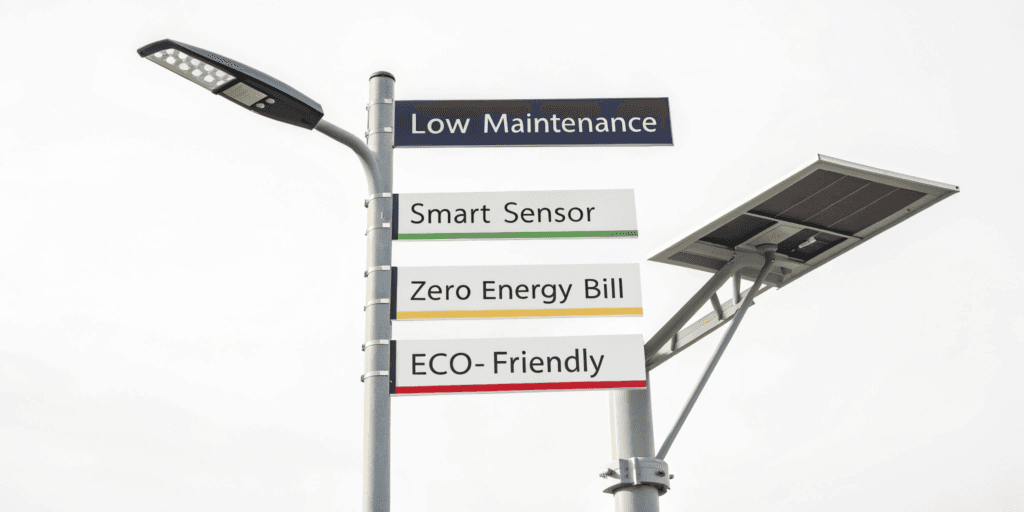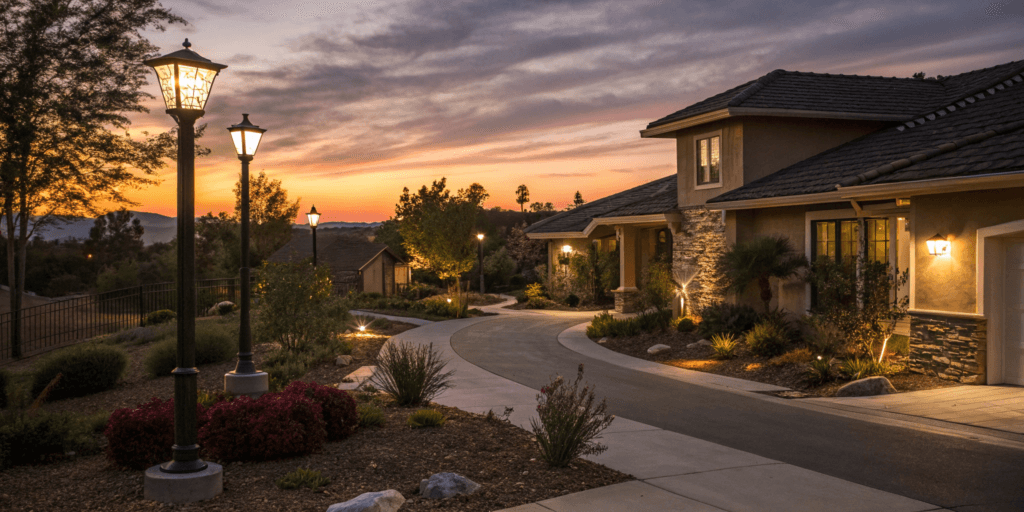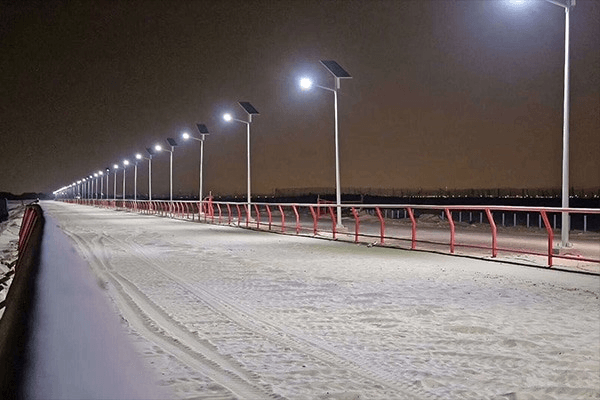Solar street lighting poles are not just a sustainable option for urban lighting but a growing technology that is reshaping outdoor lighting solutions. With advancements in solar energy and smart technologies, these lights offer energy efficiency, low maintenance, and enhanced safety for various public and private spaces.
Solar street lighting poles are transforming the way outdoor lighting is approached by combining solar power, efficient components, and smart technology to reduce energy consumption and improve functionality.
Let’s explore the technology behind solar outdoor pole lights and understand how they work.
What Are Solar Outdoor Pole Lights?
Simple Definition
Solar outdoor pole lights are lighting solutions powered by solar energy. They consist of solar panels that capture sunlight, converting it into electricity, which is then stored in batteries and used to power LED lights during the night. These lights are commonly used in outdoor settings such as streets, parks, gardens, and commercial spaces.
Key Components
Solar outdoor pole lights are made up of several important components that work together to deliver efficient and sustainable lighting:
| Component | Function |
|---|---|
| Solar Panels | Capture sunlight and convert it into electrical energy. |
| Batteries | Store the energy generated by the solar panels for use at night. |
| LED Lights | Provide high-efficiency illumination that consumes less energy. |
| Controllers | Manage energy flow and ensure proper functioning of the lights. |
| Housing | Protects the internal components and ensures durability. |
These components are built into a pole structure, making the system durable and easy to install.
The Science Behind Solar Energy and How It Powers Outdoor Lights
Solar Energy Principles
Solar outdoor pole lights rely on solar panels that convert sunlight into electricity using the photovoltaic effect. This process involves the following steps:
- Absorption of sunlight: Solar panels are made of materials like silicon that absorb sunlight.
- Conversion to electricity: The absorbed sunlight excites electrons in the material, generating an electric current.
- Storage of energy: The electricity generated is stored in batteries for use at night.
Photovoltaic Effect
The photovoltaic effect is the phenomenon by which solar panels, specifically the silicon cells, generate an electric current when exposed to light. The role of these silicon cells is crucial, as they convert the energy from sunlight into usable electrical energy.
Efficiency of Solar Panels
With advancements in technology, solar panels have become significantly more efficient. Modern panels can convert a larger percentage of sunlight into electricity, which improves the performance and longevity of solar street lighting systems. This increased efficiency reduces the reliance on grid power and optimizes energy storage.
| Panel Efficiency | Impact on Performance |
|---|---|
| Traditional Panels | Lower efficiency, requiring more space for installation. |
| Modern Panels | Higher efficiency, providing more power in less space. |
How Solar Outdoor Pole Lights Work
Daytime Operation
During the day, the solar panels are exposed to sunlight, where they convert the light into electrical energy. This energy is then stored in the batteries for use at night. The energy stored in the batteries allows the lights to operate without needing an external power source.
Nighttime Functionality

At night, the stored energy is used to power the LED lights. A controller regulates the operation of the lights, ensuring they turn on at dusk and off at dawn. This system works autonomously, requiring minimal intervention.
Smart Features
Modern solar outdoor pole lights often include sensors to optimize their performance:
- Motion Sensors: Detect movement and adjust the lighting intensity to save energy when no one is present.
- Light-Level Sensors: Automatically adjust the brightness based on ambient light levels, ensuring energy is used only when needed.
These features help in energy conservation and improve the overall functionality of the system.
Advantages of Solar Outdoor Pole Lights
Energy Efficiency and Sustainability
By utilizing solar energy, solar outdoor pole lights reduce reliance on the grid, lowering electricity consumption. Their renewable energy source also significantly reduces carbon emissions, making them a key player in promoting sustainability.
| Advantage | Description |
|---|---|
| Energy Savings | Reduces electricity bills and reliance on fossil fuels. |
| Sustainability | Contributes to environmental goals by using renewable energy. |
Cost-Effectiveness
Although the initial cost of installing solar outdoor pole lights may be higher than traditional lighting, their long-term benefits outweigh the investment. They have low operational and maintenance costs, as they do not require external electricity, and the use of durable LED lights minimizes the need for frequent bulb replacements.
| Cost Factor | Description |
|---|---|
| Low Maintenance | Minimal upkeep is needed since there are no wires or bulbs to replace frequently. |
| No Electricity Bills | Solar power eliminates ongoing electricity costs. |
Versatility and Aesthetics
Solar lights come in a variety of designs, making them suitable for different outdoor settings—from residential gardens to commercial spaces. They can also add to the aesthetics of an area while providing reliable illumination.
| Design Option | Use Case |
|---|---|
| Garden Lights | Enhance landscaping and provide safe lighting for residential gardens. |
| Street Lights | Provide high-quality lighting for public roads and pathways. |
Practical Applications of Solar Outdoor Pole Lights

Residential Use
Solar outdoor pole lights are ideal for enhancing home security and aesthetics. They are commonly installed in gardens, pathways, and driveways, providing both illumination and a sense of security.
Commercial and Public Spaces
For commercial properties and public areas, solar lights are widely used in parks, parking lots, and shopping centers. They not only improve safety but also reduce operational costs associated with traditional lighting.
Emergency and Off-Grid Situations
In areas with no access to conventional power, solar lights provide a reliable solution. They are especially useful in emergency situations or disaster-stricken areas, where access to electricity is limited or unavailable.
Future Trends in Solar Outdoor Lighting
Technological Innovations
As technology continues to evolve, advancements in solar panel efficiency, LED technology, and smart systems will further enhance the performance of solar outdoor pole lights. These innovations will contribute to making solar lighting solutions even more efficient, affordable, and widespread.
Impact of Policies and Regulations
Government policies, grants, and subsidies play a crucial role in the adoption of solar outdoor lighting solutions. These incentives are encouraging cities and businesses to invest in renewable energy solutions, promoting environmental sustainability.
Market Growth
With increasing demand for sustainable lighting solutions, the solar outdoor lighting market is expected to grow. This growth is driven by advancements in technology and the rising need for energy-efficient products.
Why Choose Solar Outdoor Pole Lights?

Environmental Responsibility
By choosing solar lights, individuals and businesses are making a responsible choice for the environment. Solar lights help reduce carbon emissions and reliance on fossil fuels, contributing to a greener planet.
Practical Benefits
Solar outdoor pole lights offer reduced energy bills, low maintenance, and long-term reliability. They provide a hassle-free solution for outdoor lighting needs.
Aesthetic and Functional Enhancement
These lights not only serve practical purposes but also enhance the visual appeal of outdoor spaces. Whether for residential or commercial use, solar lights provide both functionality and beauty.
Conclusion
Solar outdoor pole lights offer a wide range of benefits, including energy savings, sustainability, and reduced operating costs. With advancements in technology, they are becoming an increasingly viable option for outdoor lighting, enhancing both functiona


